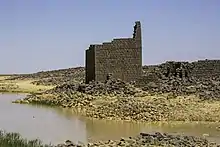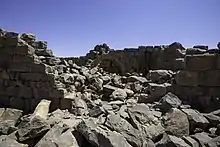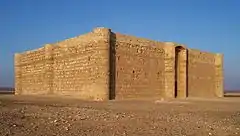Qasr Burqu'
Qasr Burqu' is a set of ruins and an archaeological site in the badia of eastern Jordan and is the site of one of the earliest of the Umayyad desert castles.

Background

Under the Umayyad Caliphate, nobles and wealthy families belonging to the Umayyad dynasty erected new complexes or adapted preexisting ones for a multitude of purposes, many being suggested: to control the roads, monitor and tax the seasonal movement of people and their livestock, impress travellers and local tribes, establish nuclei for the development of new cities, develop agriculture in semi-arid areas, and enjoy desert retreats for relaxation and hunting (see Desert castles).
History
The region where Qasr Burqu' is located has been occupied since the Neolithic period.[1]
Archaeological excavations reveal that a Ghassanid fort was established on the site and a monastery was built there during the Byzantine period.[2] It became an Umayyad castle complex in around 700 CE when al-Walid I, who was still emir, rather than caliph, either built it, or repaired existing structures to form a new palace complex.[3]
Qasr Burqu' is one of the earliest of the Umayyad desert castles in Jordan.[4]
Location and description
Although it is often described as one of the Umayyad desert castles, Svend Helms notes "it is neither a castle, nor is it in the desert" and most of the structures predate the Umayyad Caliphate.[5] It counts as one of the lesser desert castles in Jordan.[6]
Qasr Burqu' is located in the far northeast of Jordan and is one of a number of Umayyad desert castles in the semi-arid region. It is situated in the black basalt desert, about 100 km east of ad-Diyatheh, 70 km south-east of an-Namara, and about 2 km from the Wadi Minqat, which holds water from the winter rains.[7] It sits on the edge of an oasis formed on the edge of a basalt region in eastern Jordan.[8] The site was important due to its natural shallow basin, which collected rain waters in ponds.[9] Various water-catchment systems, of uncertain origin and unknown date, have been added to the site over time, in order to sustain larger populations that may have lived in the area at different times.[10]
The site's most significant surviving structure is a 5 metre tower, probably of Roman origin, and originally estimated to have been 13 metres in height.[11] The early Islamic palace complex was constructed around the Roman tower.[12]
The enclosures are constructed of basalt, and were used to pen animals by nomadic peoples attracted to the location to water their herds.[13] Rock-carved inscriptions show that Bedouin tribes used the site as a seasonal encampment each spring throughout the Medieval period.[14]
| Wikimedia Commons has media related to Qasr Burqu. |
See also
- Harrat al-Sham (Black Desert), the volcanic landscape and region it is part of
- Islamic art
- Islamic architecture
- Jordanian art
- Umayyad architecture
References
- Betts, A.V. G. (ed), The Harra and the Hamad: Excavations and Explorations in Eastern Jordan, Sheffield Academic Press, Sheffield, UK, Chapter 1
- Barker, G. and Gilbertson, D., The Archaeology of Drylands: Living at the Margin, Routledge, 2003, pp 94-96; Bowersock, G.W., Roman Arabia, Harvard University Press, 1994, p. 99
- Fowden, G., Qusayr 'Amra: Art and the Umayyad Elite in Late Antique Syria, University of California Press, 2004 p. 289
- Helms, S., "A New Architectural Survey of Qaṣr Burquʽ, Eastern Jordan", Vol. 71, September 1991 , pp 191-215; Helmes, S., "A New Architectural Survey of Qasr Burqu', Eastern Jordan, The Antiquaries Journal, Volume 71, [Oxford University Press], 1991, pp 191-193
- Helms, Svend (1991). "A New Architectural Survey of Qaṣr Burquʽ, Eastern Jordan". The Antiquaries Journal. 71: 191–215. doi:10.1017/S000358150008687X. ISSN 1758-5309.
- Kennedy & Riley, pp. 8-9
- Cameron, A. and King, G. R.D., "Land Use and Settlement Patterns." in Papers of the Second Workshop on Late Antiquity and Early Islam, Darwin Press, 1994, p. 54
- Helmes, S., "A New Architectural Survey of Qasr Burqu', Eastern Jordan, The Antiquaries Journal, Volume 71, [Oxford University Press], 1991, pp 191-193
- Kennedy & Riley, p. 71
- Barker & Gilbertson, pp. 97-99; Kennedy & Riley, p. 71
- Barker & Gilbertson, p. 96
- Kennedy & Riley, p. 71
- Kennedy & Riley, p. 72
- Winnett, F.V. and Harding, G.L., Inscriptions from Fifty Safaitic Cairns, University of Toronto Press, 1978, p. 25; Jamme, A., "Inscriptions from Fifty Safaitic Cairns," in Niditch, S., Incantation Texts and Formulalc Language: A New Etymology for hwmry, p. 478

